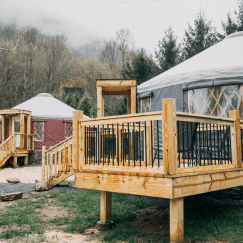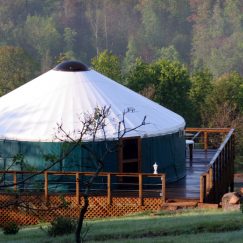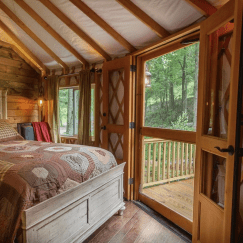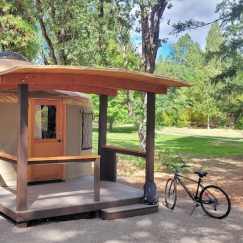How to Keep Your Yurt Warm in the Winter
We’ve covered how to keep your yurt cool in the summer. Now, as chilly mornings and changing leaves signal winter’s approach, we’re turning our attention to having a cozy, warm yurt environment in the winter months. One of the lesser-known benefits of yurts is that they’re extremely energy-efficient, allowing yurt owners to keep the temperature perfect inside even when it plummets outside.
Let’s take a look at how you can successfully heat your yurt this winter.
6 Ways to Heat a Yurt This Winter
1. Opt for Custom Yurt Features for Winter Conditions
If you haven’t yet ordered your yurt, ensure you choose options for heating. When designing a custom yurt, incorporating yurt features that inherently keep your yurt warm is crucial to maintain a cozy and comfortable interior, especially in colder climates. The options you choose will vary depending on your yurt’s location, as different regions present unique temperature and weather challenges.If you already have a yurt, consider adding these amenities:
- Insulation. Our seven-layer reflective insulation was developed by NASA. We create an attractive interior finish by covering the insulation with ivory-colored fabric.
- Insulated Window Covers. We offer easy-on, easy-off insulated window covers for our fabric windows that are made of the same reflective insulation.
- Stove flashing. Our double metal flashing allows a stovepipe to exit through the side cover. It’s available in a wide range of sizes to accommodate most stoves.
- Fan Support. Allows the installation of a ceiling fan in the center of the yurt to increase air circulation and push heat down toward the living space.
2. Add Conventional, Radiant, or Solar Heating
Heating approaches that work in traditional buildings also work for yurts. Ducts for heat pumps and central heating systems may be installed beneath the yurt’s floor or ductless heat pumps may be used. Propane stoves, pellet stoves, and wood stoves will also work but should be vented through the wall rather than the roof, as this will make it easier to clean the chimney while also minimizing the chance of roof damage by venting embers.
Electric heaters are also popular, assuming you’ve added an electrical system. Radiant heating, via below-floor or wall units, is a wonderful way to heat yurts as well. Finally, some use solar power to heat their yurts in appropriate conditions with modest heating requirements.
Whatever option you select, remember that it is always best to have two heating sources. For instance, if your heating system uses electricity, it’s smart to have a wood stove as well for times when the electrical grid is out or have a generator on hand.
3. Eliminate Heat Leaks with Improved Insulation
As in all structures, a tight building envelope will minimize heat loss. Installing foam weather-stripping to the underside of the top cover valance and between the side cover and platform will fill possible air gaps. Making sure the side cover is tight around the circumference and cinching the top cover valance cord will go a long way toward insulating your space and sealing air gaps. Finally, energetic yurt owners may wedge custom-cut foam boards between the rafters to further reduce heat loss. A winterized and insulated yurt is a leak-free yurt.
4. Place the Yurt with Winter Conditions in Mind
 If you are still in the construction phase, be sure to consider how to place your yurt for cozy winter conditions, especially if your yurt will be surrounded by snow. Place the door so that it faces away from the area’s most prevalent winds – while Pacific Yurts hold strong in any weather condition, it’s never pleasant to be greeted with a bitter winter wind right when you walk out the door. Finally, seek a spot with some winter sunshine, as this can provide passive heating for your yurt. Deciduous trees can provide shade in summer but allow passive heating in winter.
If you are still in the construction phase, be sure to consider how to place your yurt for cozy winter conditions, especially if your yurt will be surrounded by snow. Place the door so that it faces away from the area’s most prevalent winds – while Pacific Yurts hold strong in any weather condition, it’s never pleasant to be greeted with a bitter winter wind right when you walk out the door. Finally, seek a spot with some winter sunshine, as this can provide passive heating for your yurt. Deciduous trees can provide shade in summer but allow passive heating in winter.
5. Insulated Yurt Flooring
A properly insulated yurt can help you avoid losing heat through the floor. A good way to do this is to install rigid foam insulation between floor joists. Installing plywood skirting around the perimeter of the platform will also aid with insulation by stopping cold air from flowing beneath the floor. Fiberglass batting is not recommended because it is more attractive to rodents for nesting material.
6. Add a Ceiling Fan
 Our fan support will allow you to equip your yurt with a ceiling fan, one of the most useful tools for controlling temperature year-round. How does this work? Remember that heat rises. As such, the air you heat will move upward toward the dome. A ceiling fan will push that heated air downward, keeping your family and friends warm while maximizing your energy efficiency.
Our fan support will allow you to equip your yurt with a ceiling fan, one of the most useful tools for controlling temperature year-round. How does this work? Remember that heat rises. As such, the air you heat will move upward toward the dome. A ceiling fan will push that heated air downward, keeping your family and friends warm while maximizing your energy efficiency.
Contact Us for Winter Yurt Options and Support
Yurts make wonderful structures for a variety of uses, and we are passionate about helping people achieve comfort in their yurt dwellings. As winter approaches, we understand the importance of staying warm and cozy. Contact us today to chat about yurt heating options, winter preparation, customization support, and more.






